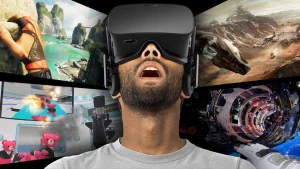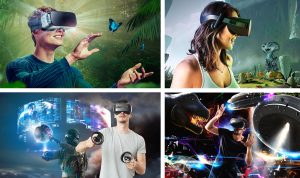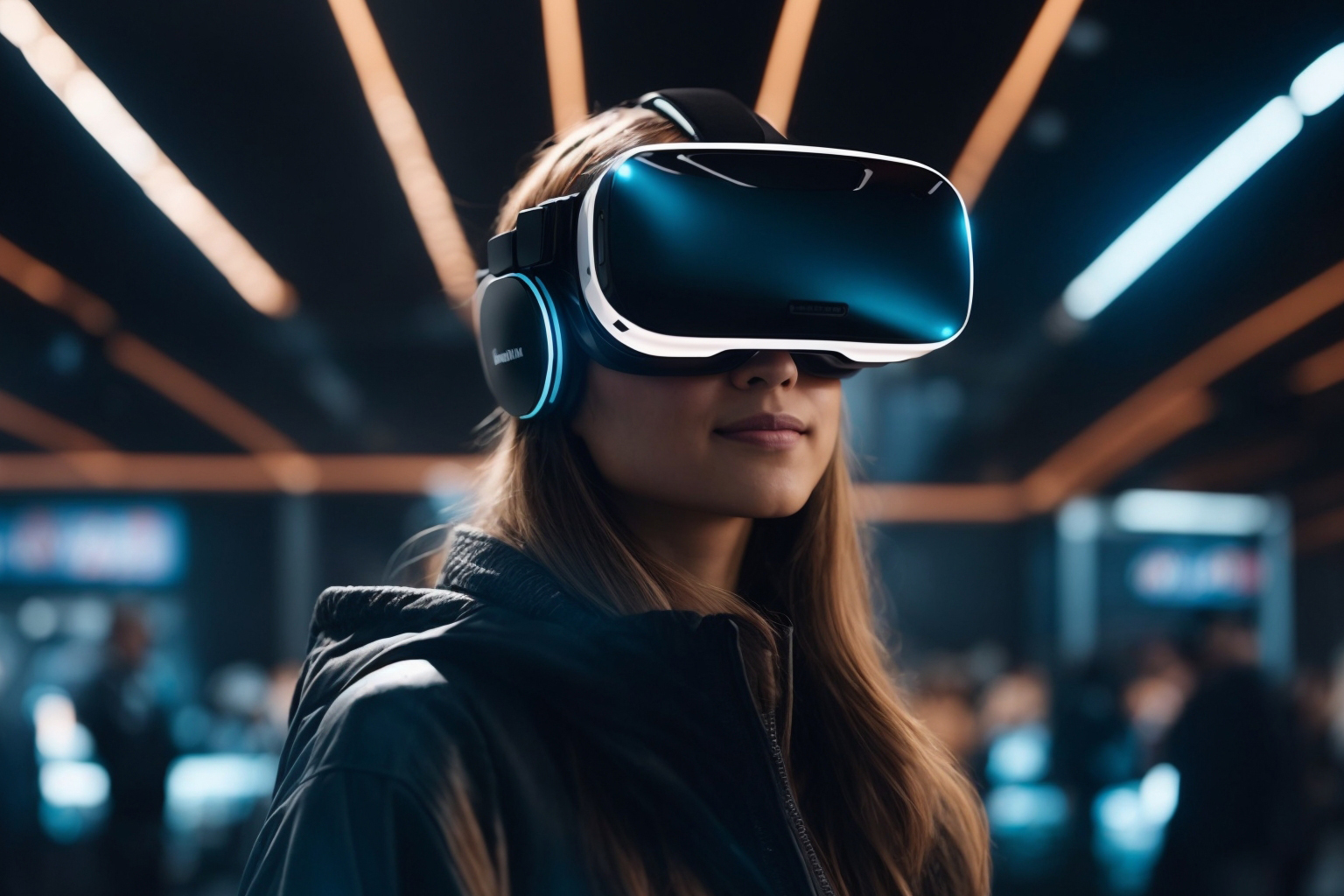Introduction
Virtual Reality (VR) has rapidly transformed the landscape of the entertainment industry, offering immersive experiences that blur the line between reality and fiction. From gaming and live events to virtual tours and cinematic experiences, VR is becoming a major driving force that shapes how we consume content. This article explores how VR is overtaking the entertainment industry, analyzing its growth, the benefits it brings, and the challenges that remain.
The Evolution of VR in Entertainment

Virtual reality first started with simple uses, like training for the military or doctors. At that time, VR was expensive and not easily available to everyone. However, over the past few years, VR technology has improved. With products like Oculus Rift and PlayStation VR, more people can now use VR in their homes. This has opened up new ways to enjoy games, movies, and even concerts.
1. Early Days of Virtual Reality
VR’s journey began with small-scale, experimental projects that aimed to create fully immersive experiences. Early VR systems were mostly used in specialized fields like military training and medicine. These early attempts faced technological limitations, but they laid the groundwork for what we see today.
2. The Breakthrough of Consumer VR
In the last decade, advances in hardware and software have made VR more accessible to the mass market. Devices like the Oculus Rift, HTC Vive, and PlayStation VR brought high-quality VR experiences to consumers, sparking a surge in demand for immersive content across multiple entertainment sectors, especially gaming.
How VR is Reshaping Various Entertainment Sectors

1. VR in Gaming
Gaming has been the most visible application of VR technology, offering players an immersive environment where they can interact with digital worlds in real time. The realism of VR gaming goes beyond traditional video games, providing players with 360-degree environments, tactile feedback, and the feeling of “presence,” making it one of the most significant shifts in the gaming industry.
2. VR in Film and Cinematic Experiences
Virtual reality is also transforming the cinematic experience by offering 360-degree films and immersive storytelling. VR films allow viewers to engage in the story as active participants, rather than passive viewers, and explore different perspectives within the narrative.
3. VR in Live Events and Concerts
Another area where VR has shown tremendous potential is live events. With VR, users can experience concerts, sports events, or theater performances from the comfort of their own homes, with a front-row seat feel. Artists and organizers have embraced VR as a way to expand their audience and overcome geographical barriers.
4. VR in Theme Parks and Interactive Attractions
Many theme parks are incorporating VR into their attractions to provide thrilling new experiences. From virtual roller coasters to interactive VR zones, the technology is being used to enhance traditional rides and offer new forms of entertainment that would not be possible in the real world.
The Benefits of VR in Entertainment

1. Enhanced Immersion
The primary advantage of VR is the level of immersion it provides. Traditional forms of media like television or video games can engage sight and sound, but VR adds a layer of interactivity and presence that creates a deeper connection to the content.
2. New Revenue Streams
For content creators, VR opens up new opportunities for monetization. Filmmakers, game developers, and even artists can create VR-exclusive experiences that attract a dedicated audience willing to pay a premium for these immersive offerings.
3. Global Access to Premium Experiences
VR breaks down physical barriers, making it possible for individuals worldwide to attend events, visit museums, or even explore distant locations virtually. Experiences that were previously unavailable due to location or expense are now more broadly available as a result of entertainment democratization.
The Power of Immersion
One of the biggest reasons VR is so popular is its ability to make you feel like you’re actually inside the experience. Unlike watching TV or playing a regular video game, VR surrounds you with the sights and sounds of a digital world. This level of immersion makes it much more engaging and fun. Whether you’re fighting monsters in a game or exploring a new planet, VR brings you closer to the action.
VR and Social Experiences
VR isn’t just for solo entertainment. Many people are now using VR to connect with others. In VR, you can meet up with friends or strangers to play games, explore virtual worlds, or attend events together. Social VR platforms are growing in popularity, allowing people to chat, interact, and share experiences without leaving home. This opens up new possibilities for group activities in a virtual space.
Making Movies Interactive

VR is also changing the way we watch movies. Traditionally, movies are something you watch from a fixed angle. But with VR, movies become interactive, allowing you to move around the scenes and see things from different viewpoints. It makes the experience much more personal, as you can explore the environment as if you are inside the movie itself. This form of storytelling adds a whole new layer of excitement to films.
VR in Education and Training
Beyond entertainment, VR is being used in education and training. Schools and companies are using VR to teach students or train employees by simulating real-life situations. For example, medical students can practice surgeries in a virtual operating room, or engineers can explore a virtual construction site. This practical, hands-on learning makes complex tasks easier to understand and perform in real life.
Challenges Facing VR in the Entertainment Industry

Despite its benefits, there are some challenges to making VR more popular. The cost of high-quality VR headsets is still too high for many people. There are also some technical issues, like motion sickness, that need to be improved. Developers need to find ways to make VR affordable and comfortable for everyone to enjoy.
1. High Costs of Adoption
One of the significant hurdles in VR’s wider adoption is the cost. High-quality VR headsets and compatible hardware remain expensive for many consumers. For developers and content creators, creating high-quality VR content also requires significant investment.
2. Technological Limitations
Despite significant advancements, VR technology still faces several limitations. Motion sickness, limited battery life, and the resolution of visuals can sometimes detract from the experience. Moreover, not all genres of entertainment are easily adapted to VR, and there are still creative challenges in fully utilizing its potential.
3. Lack of Content Diversity
While VR is making waves in gaming and live events, its penetration into other entertainment sectors is still in the early stages. To sustain growth, more diverse and mainstream content will need to be developed to appeal to a broader audience.
VR for a New Level of Gaming
In gaming, VR offers something completely different from traditional games. Instead of just sitting and watching a screen, players can feel like they are inside the game. They can turn their heads to see their surroundings, move their hands to interact with objects, and explore the game world as if they are really there. This adds excitement and realism, making gaming more fun than ever before.
Bringing People Together Through VR

VR is not only for single-player experiences. It’s also great for bringing people together. With VR, users can play games, attend virtual events, or hang out with friends from anywhere in the world. This social side of VR makes it a perfect tool for connecting people, even when they are far apart. Virtual meetups, team games, or simply chatting with friends in a virtual world can feel very real and engaging.
A New Way to Watch Movies
Movies are also being changed by VR. Instead of just sitting and watching a story unfold, VR allows viewers to be part of the scene. Imagine watching a movie where you can look around the setting, interact with characters, or even choose how the story unfolds. This makes movies more personal and interactive, giving viewers more control over their experience.
Future Outlook for VR in the Entertainment Industry

Looking ahead, VR is likely to keep growing. As technology improves and becomes cheaper, more people will use VR in their everyday lives. The entertainment industry is excited about the possibilities, and we will likely see more VR movies, games, and live experiences in the near future. As VR continues to evolve, it will change the way we enjoy all forms of entertainment.
1. Broader Accessibility
As VR technology improves and prices decrease, it’s expected that more households will adopt VR as part of their entertainment setup. Major tech companies like Meta, Google, and Apple are investing heavily in VR, driving innovation and competition that will likely make the technology more accessible.
2. Cross-Industry Integration
Another potential development is the integration of VR across various sectors within the entertainment industry. For example, we could see more hybrid experiences that blend VR gaming with live-streamed events or the use of VR in education and social media platforms.
3. Metaverse and Social VR
The future of VR entertainment is closely linked to the rise of the metaverse, a digital universe where users can socialize, work, and play in fully immersive virtual environments. Social VR platforms like Meta’s Horizon Worlds and VR Chat are already laying the foundation for this, where users can experience collective events and entertainment with friends and strangers alike.
What’s Next for VR?
The future of VR looks bright. As technology gets better, VR devices will become cheaper and easier to use, allowing more people to enjoy it. VR is expected to be used not only for games and movies but also for education, shopping, and even job training. The entertainment industry will continue to embrace VR, providing new and exciting ways for people to enjoy their favorite activities.
Analysis Table: Advantages and Challenges of VR in Entertainment
| Aspect | Advantages | Challenges |
|---|---|---|
| Immersion | Offers unparalleled immersive experiences | Can cause motion sickness and discomfort |
| Accessibility | Provides global access to events | High upfront cost of VR hardware |
| Monetization | Opens new revenue streams for creators | Requires significant investment in content |
| Content Creation | Allows for innovative, interactive storytelling | Limited content diversity in some sectors |
Comparative Table: Traditional Entertainment vs VR Entertainment
| Feature | Traditional Entertainment | VR Entertainment |
|---|---|---|
| User Engagement | Passive viewing or interaction | Fully immersive and interactive |
| Content Accessibility | Limited by geography and timing | Accessible from anywhere at any time |
| Sensory Experience | Primarily visual and auditory | Visual, auditory, and tactile |
| Cost of Access | Generally lower | High initial investment for hardware |
| Creative Flexibility | Limited by physical constraints | Endless possibilities in virtual environments |
Conclusion
Virtual Reality is no longer just a futuristic concept. It has already begun to reshape the entertainment industry in ways that were once thought impossible. From immersive gaming and interactive movies to virtual concerts and theme parks, VR is transforming how we experience entertainment. While there are still challenges to overcome, the potential for growth is immense. As technology improves and becomes more accessible, VR is poised to dominate the entertainment industry and offer experiences that are more engaging, interactive, and personalized than ever before.




